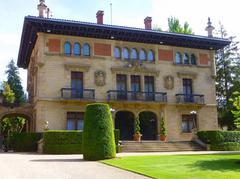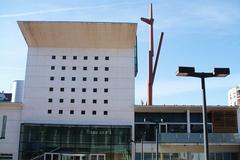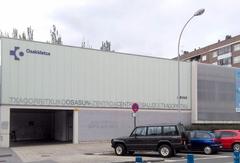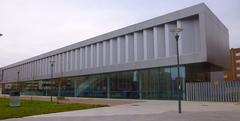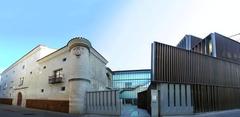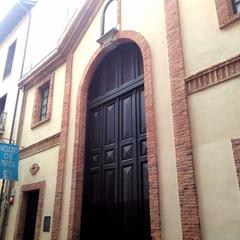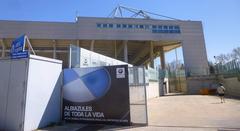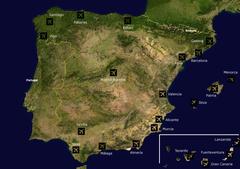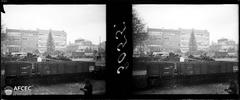Visiting Hours, Tickets, and Historical Significance of Basilica de Armentia, Vitoria-Gasteiz, Spain
Date: 24/07/2024
Introduction
The Basilica of San Prudencio de Armentia, located in Vitoria-Gasteiz, Basque Country, Spain, stands as a monumental testament to the region’s rich historical and cultural tapestry. This Romanesque basilica, initially a humble 8th-century church, rose to prominence in the 12th century when it was reconstructed and dedicated to Saint Prudencio, a revered figure in Álava’s religious heritage. The basilica’s architectural grandeur, characterized by its solid stone walls, sturdy pillars, and intricate carvings, offers a glimpse into the craftsmanship of the Romanesque period. Over the centuries, the basilica has not only served as a spiritual center but also as a crucial stop along the Camino de Santiago pilgrimage route, cementing its significance in both religious and cultural contexts (Wikipedia, SpottingHistory). Visitors to the Basilica de Armentia can immerse themselves in a historical journey that spans centuries, from its medieval importance as the seat of the bishopric to its enduring legacy as a site of annual religious celebrations and artistic masterpieces. This guide aims to provide comprehensive information on the basilica’s history, architectural details, visitor tips, and more, ensuring an enriching experience for all who step through its ancient doors.
Table of Contents
- Introduction
- Historical Background
- Refurbishments and Modifications
- Saint Prudencio - The Patron Saint
- Architectural Details
- Preservation and Cultural Heritage
- The Role of Pilgrimage
- Artistic Contributions
- Visitor Information
- Special Events and Guided Tours
- Photographic Spots
- Conclusion
- FAQ
Historical Background
Early Origins and Initial Construction
The Basilica of San Prudencio de Armentia has a rich history that dates back to the early Middle Ages. The site originally hosted an 8th-century church, which was later replaced by the current Romanesque structure in the 12th century. Initially dedicated to Saint Andrew, it was later rededicated to Saint Prudencio, a significant figure in the region’s religious history (Wikipedia).
Romanesque Architecture
The basilica is a quintessential example of Romanesque architecture, characterized by its solid stone walls, sturdy pillars, and intricate carvings. The building features a Latin cross plan, a transept, and a semicircular apse. The original Romanesque facade, although modified over the centuries, still retains elements such as the tympanum of the Lamb and the Saviour (SpottingHistory).
Medieval Significance
During the late Middle Ages, the Basilica of San Prudencio de Armentia was considered the most important spiritual center in Álava. Between the 9th and 11th centuries, it served as the headquarters of the bishopric. The basilica’s significance is further underscored by its location on the Camino de Santiago, the ancient pilgrimage route to Santiago de Compostela, which made it a crucial stop for pilgrims (Euskadi).
Refurbishments and Modifications
The basilica underwent significant refurbishments in 1776, which altered much of its original structure. Despite these changes, key elements such as the apse and the original door were preserved. The last major restoration occurred in 1964 following the partial collapse of the vault in 1961. These restorations have helped maintain the basilica’s status as one of the most important examples of medieval art in the region (Wikipedia).
Saint Prudencio - The Patron Saint
Saint Prudencio, born in Armentia in the 6th century, is a central figure in the basilica’s history. He became the Bishop of Tarazona and was known for his role as a peace arbitrator in Osma. Saint Prudencio’s legacy is celebrated annually on April 28 with a procession and open-air festival on the meadows surrounding the basilica. This event attracts numerous visitors and highlights the basilica’s ongoing religious significance (InSpain).
Architectural Details
The basilica’s architectural details are a testament to its historical and artistic significance. The interior features a breathtaking altarpiece, a masterpiece of Renaissance art that depicts the life and martyrdom of Saint Prudencio. The carved wooden figures and vibrant colors bring the biblical scenes to life, offering visitors a glimpse into the region’s rich religious heritage (InSpain).
Preservation and Cultural Heritage
In recognition of its historical and cultural importance, the Basilica of San Prudencio de Armentia was declared a Bien de Interés Cultural in 1931 and Basque Cultural Heritage in 2012. These designations have helped ensure the preservation of the basilica’s architectural and artistic elements for future generations (Wikipedia).
The Role of Pilgrimage
The basilica’s strategic location along the Camino de Santiago has played a significant role in its history. Pilgrims traveling to Santiago de Compostela would stop at the basilica, making it a vital spiritual and cultural landmark. This tradition continues today, with the basilica serving as a reminder of the region’s deep-rooted religious practices (SpottingHistory).
Artistic Contributions
The basilica’s artistic contributions are evident in its detailed carvings and sculptures. The apse, one of the few remaining elements of the original structure, features three windows with historiated capitals. These capitals, although somewhat rudimentary compared to other sculptures in the basilica, are significant works of art from the Romanesque period. The southern portico or atrium contains several pieces, including tympana and reliefs, that were incorporated from different parts of the church (Arteviajero).
Visitor Information
Visiting Hours and Tickets
The Basilica of San Prudencio de Armentia is open to visitors throughout the year. The typical visiting hours are from 10 AM to 6 PM. However, it is advisable to check the official website or contact the basilica directly for the most up-to-date information on visiting hours and any special events.
Tickets are generally not required to enter the basilica, but donations are appreciated to help with the maintenance and preservation of this historical site.
Accessibility and Travel Tips
The basilica is easily accessible from Vitoria-Gasteiz. Public transport options include buses and taxis, making it convenient for tourists. The surrounding area is also equipped with facilities for visitors with limited mobility.
Special Events and Guided Tours
The basilica hosts a variety of special events throughout the year, including religious festivals and cultural celebrations. Guided tours are available and provide an in-depth look at the basilica’s history, architecture, and art. These tours can be arranged through local tour operators or directly with the basilica.
Photographic Spots
For photography enthusiasts, the basilica offers numerous opportunities to capture its beauty. Key spots include the Romanesque facade, the interior altarpiece, and the surrounding meadows, especially during the annual celebration of Saint Prudencio.
Conclusion
The Basilica of San Prudencio de Armentia stands as a testament to the rich historical and cultural heritage of Vitoria-Gasteiz. Its Romanesque architecture, historical significance, and ongoing religious importance make it a must-visit destination for anyone interested in exploring the region’s past. The basilica’s preservation efforts and annual celebrations ensure that its legacy will continue to be honored for generations to come (Wikipedia).
FAQ
Q: What are the visiting hours for the Basilica of San Prudencio de Armentia?
A: The typical visiting hours are from 10 AM to 6 PM, but it’s advisable to check the official website for the most up-to-date information.
Q: How much are the tickets to visit the basilica?
A: Tickets are generally not required, but donations are appreciated.
Q: What are the best times to visit?
A: The best times to visit are during the annual celebration of Saint Prudencio on April 28 or during other special events and guided tours.
